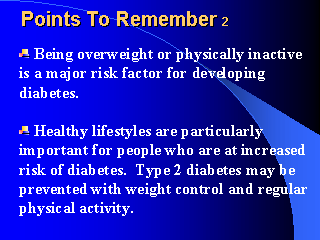|
|
|
|
front |1 |2 |3 |4 |5 |6 |7 |8 |9 |10 |11 |12 |13 |14 |15 |16 |17 |18 |19 |20 |21 |22 |23 |24 |25 |26 |27 |28 |29 |30 |31 |32 |33 |34 |review |
 |
Treatment of Type 2 diabetes should be as aggressive as possible, aiming to
achieve the best possible glucose control without introducing new complications
such as hypoglycemia. Patients should be encouraged to achieve a fasting glucose
of less than 120 mg/dL with two-hour postprandial glucose concentrations of less
than 160 mg/dL, but ideally less than 140 mg/dL. Co-morbid conditions that
increase risk for microvascular and macrovascular disease (e.g., hypertension,
smoking) should be aggressively managed.
Patients should be encouraged to maintain a normal lifestyle, and target blood glucose levels should be individualized according to the type of therapy, risk of hypoglycemia, co-morbid conditions, and projected longevity of the patient. Diet and exercise, together with education and home blood glucose monitoring, form the cornerstone of therapy for all patients. Hence, a multidisciplinary team comprising of physician, nurse practitioner, dentist and public health practitioner should ideally manage Type 2 DM patients. Aerobic exercise should be encouraged, but patients starting an exercise program should be screened for coronary artery disease. If diet and exercise fail to achieve adequate glucose control, oral hypoglycemic agents should be considered. |